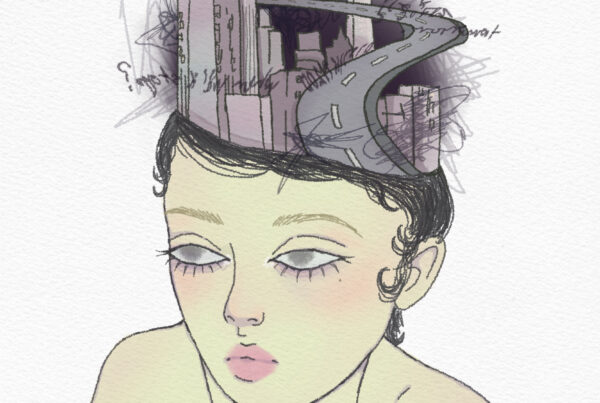
When do you feel the most alive? For most people, the feeling of being alive is akin to standing at the edge of a rooftop, exploring new and exciting destinations or simply doing the things one likes. However, when you have a chronic illness, even the simplest of tasks can be made arduous. Living becomes a chore instead of being enjoyable and fulfilling.
When do you feel the most alive? For most people, the feeling of being alive is akin to standing at the edge of a rooftop, exploring new and exciting destinations or simply doing the things one likes. However, when you have a chronic illness, even the simplest of tasks can be made arduous. Living becomes a chore instead of being enjoyable and fulfilling.

Photo by Kinga Howard on Unsplash

Photo by Kinga Howard on Unsplash
Chronic illnesses are long-lasting, progressive illnesses that last a year or longer, require medical attention, and limit daily activities (Centers for Disease Control and Prevention, 2020). Examples of such illnesses include diabetes, heart disease, cancer and many more. One is barraged with fatigue, agony and a clouded mind when experiencing the painstaking effects of these types of illnesses. The body becomes weak and patients experience a structural breakdown of their physique and psyche, ultimately leading to a loss of social functioning. For instance, a correlational study on adolescents found a relation between difficulties in social functioning and the presence of pediatric chronic illnesses (Adams, 2002).
Furthermore, individuals experience a loss of independence – as described by a patient, “you become slight and insignificant…it was hell to put it plainly” (Öhman et al., 2003). You aren’t able to make decisions for yourself or do the things you desire unless aided by someone. In a way, a vicious cycle is formed: close-knit families shape stronger support systems; however, the more help a patient receives, the more helpless and guilty they feel (Donoghue & Siegel, 2000). Besides these negative feelings, patients are at greater risk of developing depression and anxiety. The inward and invisible struggle of living with a chronic illness engenders feelings of isolation and loneliness as no-one can understand their pain except themselves. These tactics of self isolation combined with depressive tendencies can develop rapidly and cause the patient to “long for death” (Öhman et al., 2003). Individuals no longer feel alive, instead, they are tethered to the threshold between life and death – suffering and enduring.
“More importantly, because chronic illness is a permanent way of life, patients ought to be taught self-management of their disease.”
Despite these extreme feelings, many patients continue to endeavor – although this may initially be out of obligation to family members. ‘When you have children, you’re obliged to live,” says one mother experiencing chronic illness (Wilson, 2007). The tumultuous transition from obligation to truly wanting to live is a challenging yet fruitful one. Numerous parents express the strength and purpose they found from loved ones, especially their children, to continue persevering. And isn’t that what we all do? Try our best to live another day?
Besides strong support systems, the lives of people affected by chronic illnesses can be enriched through the involvement of necessary medical institutions. This comprises provision of adequate care by health workers covering the biomedical, psychological and social aspects in managing chronic illness. More importantly, because chronic illness is a permanent way of life, patients ought to be taught self-management of their disease. This is essential to patient-clinician care as it inspires independent behaviour and revitalizes their attitudes towards their illness and lives. Unfortunately, as is often the case, clinicians shoulder full responsibility for their patient’s well-being and hence, are proven to incorporate fewer self-management techniques into their treatment approach. This is contrary to what should be done: clinicians should acknowledge that they are only a small part of their patient’s lives and a large extent to which the patient’s life is improved is due to the patient themself (Glasgow et al., 2003). Hence, it is necessary for healthcare assistance to double down on self-management techniques so individuals may regain the confidence to take charge of their own lives.
In this manner, with correct healthcare assistance and family-based interventions, one can lead a healthier, more content life. Guidance and aid serve to improve our quality of life and if having a chronic illness means you require extra assistance, there is no harm in this. Thus, with some extra help, one can make the transition from simply existing to truly feeling alive.
References
-
Adams, C. D. (2002). Living With a Chronic Illness: A Measure of Social Functioning for Children and Adolescents. Journal of Pediatric Psychology, 27(7), 593–605. https://doi.org/10.1093/jpepsy/27.7.593
-
Centers for Disease Control and Prevention. (2020, May 20). About Chronic Diseases | CDC. Www.cdc.gov. https://www.cdc.gov/chronicdisease/about/index.htm#:~:text=Chronic%20diseases%20are%20defined%20broadly
-
Donoghue, P. J., & Siegel, M. E. (2000). Sick and tired of feeling sick and tired : living with invisible chronic illness. Norton.
-
Glasgow, R. E., Davis, C. L., Funnell, M. M., & Beck, A. (2003). Implementing Practical Interventions to Support Chronic Illness Self-Management. The Joint Commission Journal on Quality and Safety, 29(11), 563–574. https://doi.org/10.1016/s1549-3741(03)29067-5
-
Öhman, M., Söderberg, S., & Lundman, B. (2003). Hovering Between Suffering and Enduring: The Meaning of Living With Serious Chronic Illness. Qualitative Health Research, 13(4), 528–542. https://doi.org/10.1177/1049732302250720
-
Wilson, S. (2007). ‘When you have children, you’re obliged to live’1: motherhood, chronic illness and biographical disruption. Sociology of Health & Illness, 29(4), 610–626. https://doi.org/10.1111/j.1467-9566.2007.01008.x
Chronic illnesses are long-lasting, progressive illnesses that last a year or longer, require medical attention, and limit daily activities (Centers for Disease Control and Prevention, 2020). Examples of such illnesses include diabetes, heart disease, cancer and many more. One is barraged with fatigue, agony and a clouded mind when experiencing the painstaking effects of these types of illnesses. The body becomes weak and patients experience a structural breakdown of their physique and psyche, ultimately leading to a loss of social functioning. For instance, a correlational study on adolescents found a relation between difficulties in social functioning and the presence of pediatric chronic illnesses (Adams, 2002).
Furthermore, individuals experience a loss of independence – as described by a patient, “you become slight and insignificant…it was hell to put it plainly” (Öhman et al., 2003). You aren’t able to make decisions for yourself or do the things you desire unless aided by someone. In a way, a vicious cycle is formed: close-knit families shape stronger support systems; however, the more help a patient receives, the more helpless and guilty they feel (Donoghue & Siegel, 2000). Besides these negative feelings, patients are at greater risk of developing depression and anxiety. The inward and invisible struggle of living with a chronic illness engenders feelings of isolation and loneliness as no-one can understand their pain except themselves. These tactics of self isolation combined with depressive tendencies can develop rapidly and cause the patient to “long for death” (Öhman et al., 2003). Individuals no longer feel alive, instead, they are tethered to the threshold between life and death – suffering and enduring.
“More importantly, because chronic illness is a permanent way of life, patients ought to be taught self-management of their disease.”
Despite these extreme feelings, many patients continue to endeavor – although this may initially be out of obligation to family members. ‘When you have children, you’re obliged to live,” says one mother experiencing chronic illness (Wilson, 2007). The tumultuous transition from obligation to truly wanting to live is a challenging yet fruitful one. Numerous parents express the strength and purpose they found from loved ones, especially their children, to continue persevering. And isn’t that what we all do? Try our best to live another day?
Besides strong support systems, the lives of people affected by chronic illnesses can be enriched through the involvement of necessary medical institutions. This comprises provision of adequate care by health workers covering the biomedical, psychological and social aspects in managing chronic illness. More importantly, because chronic illness is a permanent way of life, patients ought to be taught self-management of their disease. This is essential to patient-clinician care as it inspires independent behaviour and revitalizes their attitudes towards their illness and lives. Unfortunately, as is often the case, clinicians shoulder full responsibility for their patient’s well-being and hence, are proven to incorporate fewer self-management techniques into their treatment approach. This is contrary to what should be done: clinicians should acknowledge that they are only a small part of their patient’s lives and a large extent to which the patient’s life is improved is due to the patient themself (Glasgow et al., 2003). Hence, it is necessary for healthcare assistance to double down on self-management techniques so individuals may regain the confidence to take charge of their own lives.
In this manner, with correct healthcare assistance and family-based interventions, one can lead a healthier, more content life. Guidance and aid serve to improve our quality of life and if having a chronic illness means you require extra assistance, there is no harm in this. Thus, with some extra help, one can make the transition from simply existing to truly feeling alive.
References
-
Adams, C. D. (2002). Living With a Chronic Illness: A Measure of Social Functioning for Children and Adolescents. Journal of Pediatric Psychology, 27(7), 593–605. https://doi.org/10.1093/jpepsy/27.7.593
-
Centers for Disease Control and Prevention. (2020, May 20). About Chronic Diseases | CDC. Www.cdc.gov. https://www.cdc.gov/chronicdisease/about/index.htm#:~:text=Chronic%20diseases%20are%20defined%20broadly
-
Donoghue, P. J., & Siegel, M. E. (2000). Sick and tired of feeling sick and tired : living with invisible chronic illness. Norton.
-
Glasgow, R. E., Davis, C. L., Funnell, M. M., & Beck, A. (2003). Implementing Practical Interventions to Support Chronic Illness Self-Management. The Joint Commission Journal on Quality and Safety, 29(11), 563–574. https://doi.org/10.1016/s1549-3741(03)29067-5
-
Öhman, M., Söderberg, S., & Lundman, B. (2003). Hovering Between Suffering and Enduring: The Meaning of Living With Serious Chronic Illness. Qualitative Health Research, 13(4), 528–542. https://doi.org/10.1177/1049732302250720
-
Wilson, S. (2007). ‘When you have children, you’re obliged to live’1: motherhood, chronic illness and biographical disruption. Sociology of Health & Illness, 29(4), 610–626. https://doi.org/10.1111/j.1467-9566.2007.01008.x



